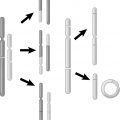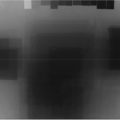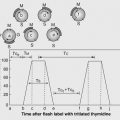7
LINEAR ENERGY TRANSFER AND RELATIVE BIOLOGICAL EFFECTIVENESS
YVONNE PHAM AND CHIRAG SHAH
Question 1
What is the definition of linear energy transfer (LET)?
Question 3
What is considered high (densely ionizing) linear energy transfer (LET) radiation versus low (sparsely ionizing) LET radiation?
Question 1 What is the definition of linear energy transfer (LET)?
Answer 1
LET is the average energy transferred per unit path length of travel within the local medium, expressed in kiloelectron volt (keV) per micrometer (μm). Energy deposition per path length varies widely due to the primary radiation and electrons set in motion; thus, LET is an average quantity.
Hall EJ, Giaccia AJ. Linear energy transfer and relative biologic effectiveness. In: Hall EJ, Giaccia AJ, eds. Radiobiology for the Radiologist. 7th ed. Philadelphia, PA: Lippincott Williams & Wilkins; 2012:104–113.
Question 3 What is considered high (densely ionizing) linear energy transfer (LET) radiation versus low (sparsely ionizing) LET radiation?
Answer 3
Radiation with LET values less than 10 keV/μm are considered low LET while radiation with LET values greater than 10 keV/μm are considered high LET.
Podgorsak, EB. Introduction to modern physics. In: Greenbaum E, ed. Radiation Physics for Medical Physicists. 2nd ed. New York, NY: Springer Science & Business Media; 2010:1–76.
Question 5
What are some linear energy transfer (LET) values for different radiation types?
Question 5 What are some linear energy transfer (LET) values for different radiation types?
Answer 5
LET Values | |
Radiation Type | LET (keV/μm) |
Cobalt-60 γ-rays | 0.2 |
250-kV x-rays | 2.0 |
1 MeV electrons | 0.25 |
10 keV electrons | 2.3 |
150 MeV proton | 0.5 |
2 MeV proton | 17 |
14 MeV neutrons | 12 |
100 MeV carbon ion | 160 |
2.5 MeV α-particle | 166 |
75 MeV argon ion | 250 |
2 GeV Fe ions | 1,000 |
Hall EJ, Giaccia AJ. Linear energy transfer and relative biologic effectiveness. In: Hall EJ, Giaccia AJ, eds. Radiobiology for the Radiologist. 7th ed. Philadelphia, PA: Lippincott Williams & Wilkins; 2012:104–113.
Podgorsak EB. Introduction to modern physics. In: Greenbaum E, ed. Radiation Physics for Medical Physicists. 2nd ed. New York, NY: Springer Science & Business Media; 2010:1–76.
Stay updated, free articles. Join our Telegram channel

Full access? Get Clinical Tree






